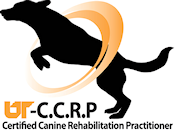Services
Working canines that are participants in sporting activities such as agility, flyball, Search and Rescue, and Law enforcement are subjected to extreme stresses, especially to their musculoskeletal system. All of the services provided are directed to minimize potential for injury and to attain the highest level of performance.
Therapeutic exercise is used to improve range of motion, increase muscle mass and strength. This modality also includes re-education for patients with neurological problems to augment their motor function skills.
Conditioning
Sports fitness conditioning in our working dogs, reduces injury risk as well as increasing the canine athlete’s fitness and coordination. We use several types of conditioning exercises tailored to the situation, i.e. coming back from an injury vs. surgery. Conditioning the healthy athlete is one of the most important aspects of keeping our partners at their peak of performance.
Massage
When a soft tissue injury (i.e. muscle, ligament, or tendon) occurs, the pain associated with the inflammation causes the muscles in the area affecedt to contract reflexively. One of the result of this contraction is to reduce blood flow to the area, with resultant decrease in oxygenation of the muscles, which in itself causes pain. Thus a cycle of pain – contraction – more pain is formed. Using various forms of massage ranging from light massage to cross frictional massage we can alleviate and break this cycle. We also employ acupressure and myofascial release techniques to achieve these goals.
All of these techniques can be used both prophylactically, contributing to the well-being and soundness of the dog, as well as therapeutically to increase range of motion, muscle mass and strength after surgery.
Low Level Laser Therapy (LLLT)
Lasers emit energy in discrete packets called photons. Soft tissue has several responses when exposed to this energy. As the energy penetrates deep into the targeted tissue, it causes increases in cellular energy in the form of ATP. This increases the cellular metabolism. Because of this, the cells of muscles, tendons and ligaments are able to repair themselves faster than they would without the benefit of LLLT.
In connective tissue, the increased energy levels of fibroblasts lead to an increased production of collagen, which is the primary essential protein needed for repair and replacement of tissue. Laser energy applied to wounds heal faster and with less fibrotic scar formation.
At the level of the circulation, Laser energy increases the blood flow as well as increasing the formation of new capillaries in a traumatized area. It also is responsible for increasing the activity of the lymphatics and in reducing the amount of edema in the affected area.
Locally, the Laser decreases the sensitivity of nerves, thus producing an analgesic affect in the area treated. Systemically, Laser has been shown to increase the production of endorphins and enkephalins at the level of the brain, adrenals and other organs. These neuro-modulators act to decrease pain and to give the patient an over-all sense of well-being.
Low Level Light Therapy is particularly indicated in:
- Diseases of the musculo-skeletal system
- Muscle strains and sprains
- Skin lesions and wounds
- Post-surgical and traumatic wounds
- Joint, ligament or tendon injuries
